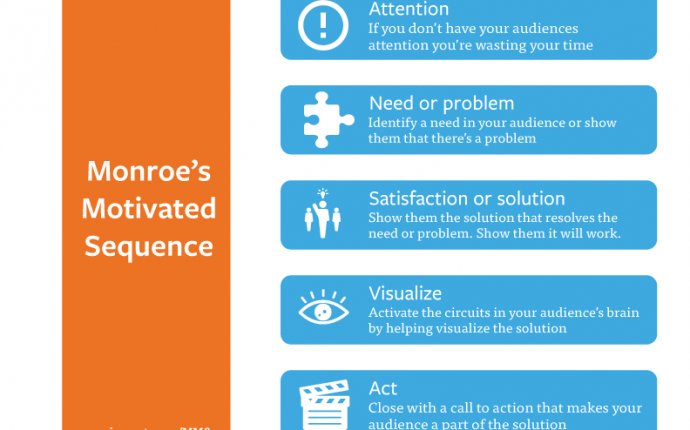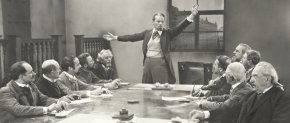
Monroes motivated Sequence example
 BY JESSICA ZARTLER
BY JESSICA ZARTLER
Have you ever watched a speech or presentation that inspired you? One so motivating that it roused you to action? Ever wish you had that skill? (Me too!)
Yes, some people are more enthusiastic and have a natural charismatic energy that can be persuasive, but even without being Tony Robbins, you too can drive more engagement in your presentations, speeches to your team, talks with a client or sales pitches.
The answer lies within a technique called Monroe’s Motivated Sequence. With just five steps, you can deliver more memorable presentations and develop your powers of persuasion.
What is Monroe’s Motivated Sequence?
Developed in the mid-1930s, it is an outline for making speeches that deliver results. It was developed by Alan H. Monroe, a Purdue University professor, using the psychology of persuasion.
The Motivated Sequence derives its name from the fact that by following the normal processes of human thinking, it motivates an audience to respond affirmatively to the speaker’s purpose.
When anything throws people into a condition of disorganization or dissonance, they are motivated to adjust their values, or to alter their behavior so as to achieve a new state of balance.- Alan Monroe
The 5 Steps of Monroe’s Motivated Sequence
1. Attention: Grab the attention of your audience
Hey! Listen to me, you have a PROBLEM!
In addition to establishing credibility, stating your purpose and letting the audience know what to expect in your speech or presentation, the introduction should grab the attention of your audience. Use storytelling, humor, a shocking statistic or a rhetorical question to get your audience or customers to stop what they are doing and pay attention.
EXAMPLE: Fewer than one-third of projects were completed on time and budget in the past year. For every $1 billion invested, organizations lose $109 million in poor project management. (Standish Group/Project Management Institute)
 2. Need: Demonstrating a need for change
2. Need: Demonstrating a need for change
Let me EXPLAIN the problem.
Next, you must convince your audience that there is a problem and what is happening right now is not sufficient and it needs to improve. Use statistics and facts related to your topic, discuss what will fail by keeping the status quo and show your team or clients how the problem directly affects them. Before you propose a solution, your audience must feel ready to accept it. You should make them feel restless enough that they are waiting for you to suggest the change(s) they need to make.
EXAMPLE: One-third of all projects fail because of a lack of involvement from senior management and 44 percent of all project managers use no software, even though PWC found that the use of PM software increases performance and satisfaction. Using email and Excel to manage projects offers no reminders or notifications, no file management, no place to communicate and no overview or analytics, and sets your team up for major failure.
3. Satisfaction: Present a practical and concise solution
But, I have a SOLUTION!
Having left your audience feeling restless and in need of a revolution, it is now time to present your plan or solution. This is the meat and potatoes, if you will (tofu and chickpeas for vegetarians), of your presentation. It will vary a lot depending on your purpose but you will want to put the most energy in this third section. Discuss the facts once again, give details to make sure your audience understands your position and clearly state what you want the audience to do or believe.
Summarize from time to time when you are discussing this part and use examples and testimonials to prove your solution will deliver results. Prepare for all the potential challenges and counterarguments that may come. You may even want to role play or discuss possible objections with a colleague or friend.
EXAMPLE: A high performing project manager needs a way to track projects from start to finish, get the team on board to work together towards a common goal and get more done on time and under budget. Project management software, Taskworld, takes the guesswork out of managing teams and projects, and saves time and money.
4. Visualization: Allow your audience to picture the results
If we IMPLEMENT my solution, this is what will happen. Or, if we don’t implement my solution, this is what will happen.
You’ve presented your solution, now intensify your audience’s desire for that plan by helping them visualize the future. Use vivid imagery to show your listeners how they will benefit from your recommendation. Make sure your vision is realistic and believable. You can use one of three methods to get the audience to share your vision:
The Positive Method — Describe what the situation will look like if the audience accepts your plan and highlight the positive aspects.The Negative Method — Describe what will happen if listeners reject your idea and focus on the dangers of not acting.The Contrast Method — Share the negative picture first and then compare that to the amazing things your plan could bring if adopted.Whichever of these three routes you choose, the visualization step should describe a future that is easily attained. Most of all, it must be vivid and your audience should be able to actually feel what it would feel like to enjoy the benefits or suffer the evils of the status quo.
EXAMPLE: With Taskworld, you can complete more projects on time and under budget, maintain better communication and collaboration with your team and save time and reduce stress. Enterprises that use Taskworld shave hours off of time spent in meetings, save two to three days per month and have been shown to reduce emails by up to 40 percent.









